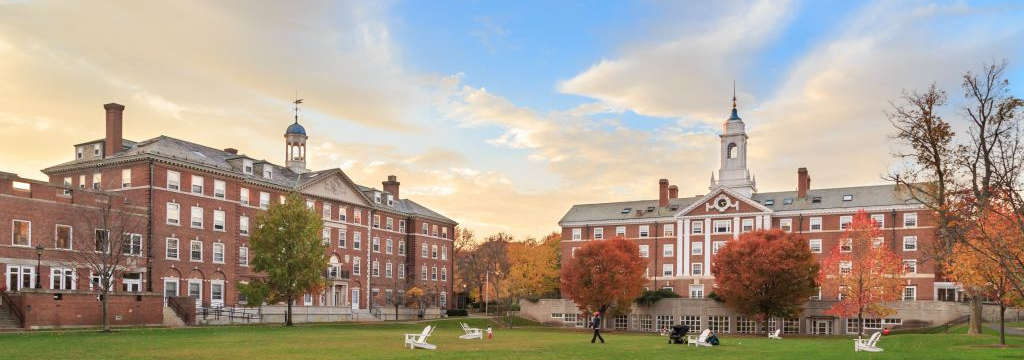IvyWise On-Demand: A Look Inside Public Colleges and Universities with Former Admissions Directors
With over 700 four-year public colleges and universities in the U.S., there are likely several great-fit options for you to consider. Join IvyWise college admissions counselors James and Mike as they introduce the different types of public colleges and universities and the academics, social life, and campus opportunities available at each.
Watch Now
Choosing between in-state and out-of-state colleges is an important decision that can significantly impact your college experience. In-state institutions often offer financial advantages, with lower tuition costs and potential access to state-funded scholarships. However, out-of-state colleges may provide unique opportunities, diverse cultural experiences, and access to specialized programs not available locally. Keep reading to learn more about in-state vs. out-of-state colleges.
What Are In-State Colleges?
In-state colleges typically refer to public institutions within your state of legal residence — these range from community colleges to large state universities — that are funded by state taxes. These types of colleges can offer a variety of advantages for local students, though they also have their limitations. You can find a wide variety of in-state colleges, so it’s worth researching your options to find out which ones are the best fit for you in terms of academics, clubs and activities, research and internship opportunities, financial aid, and campus culture.
What Are Out-of-State Colleges?
Out-of-state colleges are located outside of your state of legal residence. Again, these are typically public schools that are funded by the state. Just like with in-state schools, the variety and size of colleges can differ widely, and each school will have its own unique culture, offerings, and opportunities. If you’re interested in attending a public out-of-state college, there are many advantages and disadvantages to consider as you do your research and craft your list of best-fit schools.
Benefits of Attending an In-State College
Attending an in-state college offers several notable benefits, such as lower tuition costs and closer proximity to home. In-state students typically receive discounted tuition rates, making education more affordable. Additionally, state-funded scholarship programs and other financial aid opportunities may be accessible to in-state students, further easing the financial burden of higher education.
Being closer to home means that you can more easily maintain connections with family, friends, and others in your support systems. This sense of familiarity and comfort may help make your transition to college feel much smoother. Another advantage of staying close to home is that you will have local internship and networking opportunities, which can help you establish connections within your home state’s job market.
Drawbacks of Attending an In-State College
While attending an in-state college has its advantages, there are some potential drawbacks to consider. Depending on the institution, students may find a more limited range of academic programs and specialized courses compared to larger out-of-state or private schools. In-state colleges may not offer the same level of diversity in terms of majors and research opportunities.
Additionally, students seeking a change in scenery and exposure to different cultures may not enjoy the same breadth of experiences as attending a college in a different region. They may miss out on the opportunity to build a broader professional network that often comes with attending a college in a different state. And for some students, staying close to home limits their personal growth and independence.
Advantages of Attending an Out-of-State College
While it may not be as cost-effective as attending an in-state school, enrolling in an out-of-state college can provide you with a range of opportunities and experiences that you may not have otherwise. Let’s look at some of the advantages of attending an out-of-state college.
Academic and Research Opportunities
Depending on your options for in-state schools, you may find more academic programs, research opportunities, and specialized courses at an out-of-state school. This largely depends on the amount of funding and resources a school has, as well as the expertise and interests of the faculty, regional and state needs, accreditation and standards, student demand, and government policies, among other things.
New Cultural Experiences
Each region has its own history, customs, traditions, and social dynamics. Students attending an out-of-state college can immerse themselves in a different local culture, whether it’s exploring regional cuisine, participating in local events and festivals, or engaging with community traditions. For some students, this may enhance the college experience even more.
Different Environment
Out-of-state colleges can offer a change of scenery, whether you’re looking for an urban, suburban, or rural landscape. The geographical features, local landmarks, and natural surroundings create a unique backdrop for your college experience. Additionally, you may experience different weather patterns, seasons, and outdoor activities than you’re used to at home, depending on how far away you move.
Career Opportunities
Out-of-state schools may be in areas with specific industries and economic strengths that differ from your local area. This can open doors to job opportunities and internships that may not be available at an in-state school. Other factors, such as alumni networks, networking events, and local job markets can also enhance your job prospects.
Self-Reliance and Independence
Being far from home encourages you to manage daily tasks and make decisions independently. This builds your self-reliance since you learn to adapt to life away from the familiar support systems of family and friends. Managing your finances will become a significant aspect of your independence, since you may need to budget for living expenses, transportation, and other costs.
Disadvantages of Attending an Out-of-State College
Moving out of state for college also presents some disadvantages, so it’s important to consider these as you narrow down schools for your college list.
Cost of Tuition
One of the most significant drawbacks is the higher tuition for out-of-state students — not only to attend classes in person but for online degree programs, too. The non-resident cost of attendance is often substantially higher than the in-state rate, potentially leading to increased student loan debt and financial strain. This can limit the accessibility of certain schools for students and families with financial barriers.
Distance From Home
Being physically distant from family and established support systems can be emotionally and financially challenging depending how far you go. You may miss out on the immediate assistance and guidance that family and close friends provide during times of stress or uncertainty. It can also be challenging to return home quickly if the need arises, especially if travel expenses and time constraints are a factor.
Difficulty Adapting
Navigating the local area, finding essential services, and adjusting to a different cultural and social environment can be challenging. Some college students may experience homesickness, isolation, or difficulty adapting to the different surroundings, lifestyles, local customs, and social norms.
Home State Job Market
Graduates of out-of-state colleges may face challenges in securing employment in their home state if their education is not directly aligned with local job market needs. Additionally, attending college in a different state may limit your ability to network and make connections that could help you find employment in your home state.
What’s the Difference Between In-State and Out-of-State Tuition?
By now, you are aware that the cost of attendance for in-state schools is usually much less than for out-of-state. This is typically only true for publicly funded schools — private colleges and universities generally do not distinguish between in-state and out-of-state tuition, meaning the average tuition cost is the same regardless of your state of residence.
What Is In-State Tuition?
The rationale behind in-state tuition is to provide an affordable college education for residents of a state who have contributed to that state’s tax base through their families or their own income. Public colleges and universities are funded in part by state tax dollars, and in-state tuition reflects a subsidized rate for residents. These reduced tuition rates are typically offered to students who meet specific residency requirements, which vary by state and institution.
What Is Out-of-State Tuition?
Out-of-state tuition is the higher tuition rate charged to students who do not meet the residency requirements of the state where the college or university is located. Out-of-state students often pay a significantly higher tuition rate to compensate for the fact that they haven’t contributed as much to the state’s tax base.
What Are the Basic In-State Tuition Requirements?
To qualify for in-state tuition, a student usually needs to demonstrate that they have established legal residency in the state for a specific period, often at least one year, prior to applying for admission. This may involve proving factors such as permanent residence, employment, and financial independence in the state.
How to Get In-State Tuition at Out-of-State Colleges?
Qualifying for in-state tuition at an out-of-state college is possible, though it might take some work. If you’re interested in one or more out-of-state schools, here are some ways you might be able to get in at the in-state rate or at least save money to offset the higher costs:
- Become a legal resident: This doesn’t just involve moving to a new state to attend school. You generally need to live there for a certain length of time, establish financial independence, work and pay state income taxes, and follow any other residency requirements that qualify you for in-state tuition.
- Explore regional exchange programs: There are four regional exchange programs in the U.S. that allow you to get discounted tuition at public colleges and universities in participating states: Western Interstate Commission for Higher Education, New England Board of Higher Education, Southern Regional Education Board’s Academic Common Market, and Midwest Student Exchange Program.
- Research reciprocity agreements: Two states will sometimes make an agreement to offer in-state tuition at certain colleges and universities to eligible students from the other state. For example, Ohio has reciprocity agreements with Indiana, Kentucky, and West Virginia.
- Check into your parents’ colleges: Some schools offer legacy scholarships or lower tuition rates to children of alumni. Examples include the University of Virginia, the University of Missouri, and the University of Kentucky.
- Look at online degree programs: While it’s true that many public colleges and universities charge out-of-state tuition even for online degree programs, you won’t have additional expenses like campus housing or a meal plan. This makes it a cost-effective option for some, though it doesn’t offer the full college experience.
You may find some schools that offer lower tuition rates regardless of your residency status — colleges and universities sometimes do this to attract talented students from outside of the state. Regardless of which schools you add to your list, be thorough during the financial aid process and look for merit scholarships and other financial aid opportunities that can help offset tuition costs. Federal student loans are always an option, but it’s worth investing the time to look for alternatives that you don’t have to repay.
Popular Public In-State and Out-of-State Universities
If you’re interested in attending an out-of-state university, it’s important to know as much as possible about admission statistics — though not all schools report their admission rates for in-state and out-of-state students. Some schools accept larger numbers of out-of-state students than others.
Here are some popular public colleges and universities along with their in-state, out-of-state, and international undergraduate admission percentages. This data is for the class of 2028.
Some states require publicly funded schools to accept a certain percentage of in-state students. For example, under Texas law, in-state auto admits must make up at least 75% of all admission offers at state-funded colleges and universities. Public institutions in Colorado are capped at enrolling 45% of their incoming class with out-of-state students.
Crafting your college list can be time-consuming, but IvyWise can help save you time. Did you know that we provide College Summary Reports to help students learn more about their schools of interest? Contact us to learn more.




